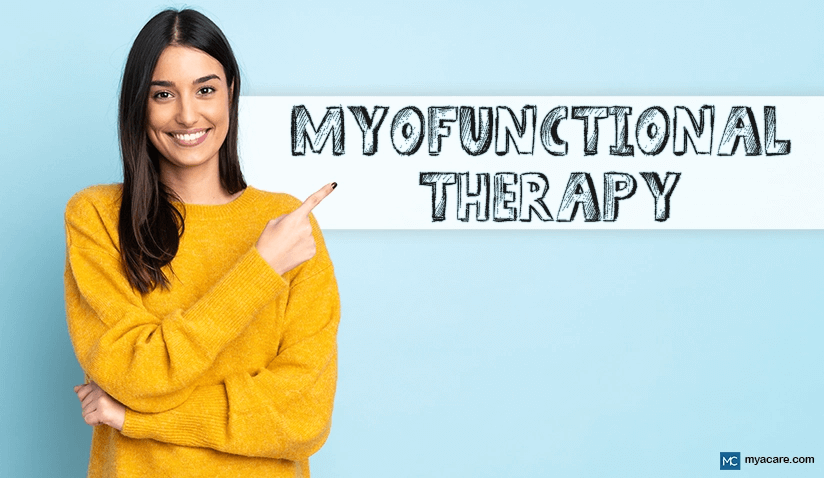Myofunctional Therapy: How It Works and What to Expect

Medically Reviewed by Dr. Shilpy Bhandari
How Myofunctional Therapy Works
Benefits of Myofunctional Therapy
The Myofunctional Therapy Process
What to Expect During Myofunctional Therapy
Myofunctional therapy (MFT) is a specialized therapy that focuses on training the weakened muscles of the face, tongue, mouth, and throat to improve their function and coordination, leading to better breathing, speech, and overall health.
According to some studies, MFT can be as effective as CPAP (continuous positive airway pressure), the leading treatment for sleep apnea, without the associated discomfort and side effects, such as noise and nasal congestion.[1] MFT is used to treat a variety of other conditions, including TMJ dysfunction, dental problems, and speech and communication disorders.
According to specialists, these conditions are highly prevalent, affecting up to 38% of the population and up to 81% of children with speech problems.[2] Many of these conditions stem from mouth breathing and poor jaw alignment, which myofunctional therapy can help correct.
Professionals treating orofacial myofunctional disorders include dentists, orthodontists, doctors, and speech therapists.
This blog covers how myofunctional therapy works and the many benefits it can provide.
How Myofunctional Therapy Works
Myofunctional therapy targets specific facial, mouth, and throat muscle groups. These muscles are responsible for crucial functions such as breathing, chewing, swallowing, speaking, and keeping the airways open during sleep.
When the facial muscles are feeble or not functioning properly, they can prevent proper airflow, interrupt breathing, and interfere with other vital functions.[3]
Myofunctional therapy aims to enhance the strength of the muscles in the face, oropharynx, and the tongue. It also emphasizes maintaining the appropriate placement of the tongue within the oral cavity. Correcting tongue posture/position is particularly pertinent for treating a "tongue thrust" habit in children[4], as this leads to jaw misalignment, mouth breathing, sleep-disordered breathing, and poor oral hygiene.
If very weak, the muscles of the throat and mouth can collapse, leading to sleep-disordered breathing and sleep apnea. A weakened tongue can also block the airways by falling to the back of the mouth when the head tilts backward. Weak orofacial muscles can lead to a variety of other issues, known as myofunctional disorders, including TMJ dysfunction, dental problems,and speech and communication disorders.
During myofunctional therapy, a therapist will work with a patient to identify any issues with these muscle groups and develop a personalized treatment plan to address them. Therapy includes exercises and stretches for the face, mouth and tongue, and other strategies to improve muscle function and coordination.
Types of Myofunctional Therapy
There are several types of myofunctional therapy, each with specific focus and techniques. Some of the most common types include:
- Oral Myofunctional Therapy: This therapy focuses on the mouth and tongue muscles and is often used to treat issues related to poor tongue posture. Dental practitioners and orthodontists utilize this therapy while addressing concerns related to teeth movement due to the pressure exerted by the tongue against the teeth (known as tongue thrust).
- Facial Myofunctional Therapy: This type of therapy focuses on the muscles of the face and is often used to treat issues such as TMJ dysfunction, facial muscle weakness, and asymmetry.
- Orofacial Myofunctional Therapy: This type of therapy combines oral and facial myofunctional techniques to address various issues in the mouth and face.
Benefits of Myofunctional Therapy
Myofunctional therapy offers a wide range of benefits for both children and adults. Some of the most notable benefits include:
For Sleep Apnea and Breathing Issues
Myofunctional therapy can complement CPAP (continuous positive airway pressure) therapy for sleep apnea. The treatment can help lower sleep apnea severity and improve overall breathing patterns by improving the muscles' function and coordination.
Results from studies reveal that MFT is as effective as CPAP for treating sleep apnea without the side effects. It can improve sleep quality, daytime sleepiness, snoring[5], and oxygenation and positively impact sleep apnea scores, such as AHI (Apnea-Hypopnea Index).
For TMJ Dysfunction and Facial Development
Myofunctional therapy can also benefit those with TMJ dysfunction and related pain, as it can aid in improving the alignment and function of the jaw muscles. Additionally, myofunctional therapy can aid in facial development, as it can help strengthen and balance the muscles of the face.[6] It can improve the effects of oral braces and similar devices.
A handful of studies show that myofunctional therapy can improve symptoms of pain and is effective whether used alone or with other therapies.
For Speech and Communication
Myofunctional therapy is often used as a form of speech therapy, as it can help improve the coordination of the muscles involved in speech.
Working orofacial muscles can be especially beneficial for those with speech and communication disorders, such as lisps or stuttering. People with these disorders tend to battle to pronounce 'S,' 'Z,' or 'SH' sounds. Studies show that myofunctional therapy can help reinforce the muscles involved and improve or correct these speech difficulties.
Myofunctional Therapy vs Speech Therapy: Speech therapy and myofunctional therapy are similar yet distinct practices. Speech therapy aims to improve communication skills by enhancing sound production and expression, while myofunctional therapy focuses on correcting patterns and habits that affect oral and facial functions like breathing, swallowing, and articulation.[7]
Other Benefits
In addition to the above benefits, myofunctional therapy can also help with:
- Improved tongue posture
- Stronger facial muscles
- Reduced tongue thrust
- Better jaw alignment
- Lower occurrence of teeth grinding (bruxism)
- Improved tongue position
- Reduced mouth breathing
- Less frequent headaches or jaw tension
- Enhanced facial symmetry and aesthetic
- Lowering the risk of acid reflux
- Better overall oral health
For children, myofunctional therapy can help curb thumb sucking and improve jaw alignment throughout the lifespan.
The Myofunctional Therapy Process
The myofunctional therapy process typically begins with an evaluation by a trained therapist. During an initial consultation, the therapist will assess the patient's muscle function and coordination and any issues or concerns that need to be addressed.
Once the evaluation is complete, the therapist will design a personalized treatment program for the patient to correct the initial problem.
This plan may provide the patient with a variety of exercises and techniques to improve muscle function and coordination of the specific muscles causing the problem.
The therapist will also provide guidance and support throughout the treatment process.[8]
It can take up to 4 months on average for results[9]. After completion, attending follow-up consultations to monitor your progress and ensuring you maintain healthy muscle alignment is helpful.
What to Expect During Myofunctional Therapy
During myofunctional therapy, patients can expect to learn various exercises and techniques to improve muscle function and coordination. They must perform the exercises several times a day, as instructed by a medical professional.
Here are a few examples of myofunctional therapy exercises to try[10]:
- Tongue Touches: Place your tongue's tip on the hard part of your roof and glide it backward 20 times.
- Tongue Presses: Pull your tongue upwards against your roof, pushing your whole tongue against it 20 times.
- Teeth Touches: Strive to join the back part of your tongue to your mouth's roof while holding the tip connected to your bottom front teeth. Perform this exercise 20 times.
- Taco Tongue: Twist your tongue longitudinally to mimic a taco shape, push it forward out your mouth, and hold position. Sustain for ten seconds, and then ease up. Do this ten times.
- Tongue clicking: Click your tongue against your palate. It should make a sound. Repeat clicking for 15 seconds, and complete this routine ten times.
- Nose or Chin touches: Extend your tongue out of your mouth and aim to touch the tip of your nose with it. Maintain this for ten seconds, then release. Perform this exercise ten times. Do the same for the chin ten times.
- Side tongue rests: Protrude your tongue and sway it to the farthest left point it can reach. Retain this for ten seconds, then break. Carry out this routine ten times before doing it again, reaching the right side.
- Vowel Exercise: Recite each vowel audibly (a, e, i, o, u). Do this exercise for intervals of three minutes several times a day.
- Uvula Raises: This exercise involves raising the uvula (the tissue that hangs in the back of the throat) by making an "A" sound 20 times.
- Sing Along: Engage in a melody you appreciate. Singing involves muscles in the face, throat, and soft palate. Regular singing sessions can aid in decreasing snoring.
- Balloon Inflation: This exercise involves inflating a balloon by inhaling via your nose and blowing out into the balloon in 5 large breaths.
- Liquid Suction: This exercise involves sucking yogurt through a straw, which can help strengthen the muscles of the mouth and throat.
- Party Horn: This exercise involves blowing into a party horn, which can help improve the strength and coordination of the muscles involved in speech.
Risks and Side Effects of Myofunctional Therapy
Myofunctional therapy is considered safe and has no significant risks or side effects. However, some may experience minor discomfort or soreness in the face, mouth, or throat muscles during or after therapy. This is normal and should subside within a few days.
Conclusion
Myofunctional therapy is a specialized treatment option that focuses on the muscles of the face, mouth, and throat muscles. It can be used to treat a variety of conditions, including sleep apnea, TMJ dysfunction, speech, and communication disorders. By improving muscle function and coordination, myofunctional therapy can offer many benefits for those of all ages. If you are considering myofunctional therapy, be sure to consult with a trained therapist to devise a tailored exercise plan that meets your specific needs and goals.
To search for some of the best Ear, Nose Throat (ENT) worldwide, please the Mya Care search engine
To search for the best dentists in Germany, India, Malaysia, Poland, Singapore, Spain, Thailand, Turkey, the UAE, the UK and the USA, please use the Mya Care search engine.
To search for the best healthcare providers worldwide, please use the Mya Care search engine.
The Mya Care Editorial Team comprises medical doctors and qualified professionals with a background in healthcare, dedicated to delivering trustworthy, evidence-based health content.
Our team draws on authoritative sources, including systematic reviews published in top-tier medical journals, the latest academic and professional books by renowned experts, and official guidelines from authoritative global health organizations. This rigorous process ensures every article reflects current medical standards and is regularly updated to include the latest healthcare insights.

Dr. Shilpy Bhandari is an experienced dental surgeon, with specialization in periodontics and implantology. She received her graduate and postgraduate education from Rajiv Gandhi University of Health Sciences in India. Besides her private practice, she enjoys writing on medical topics. She is also interested in evidence-based academic writing and has published several articles in international journals.
Sources:
Featured Blogs



